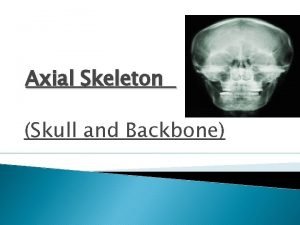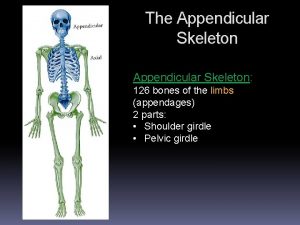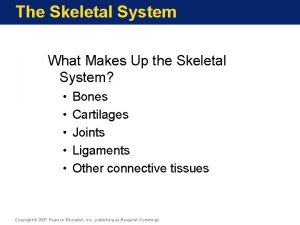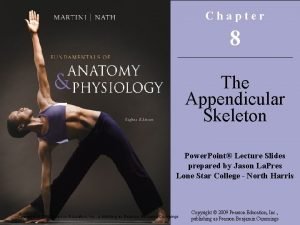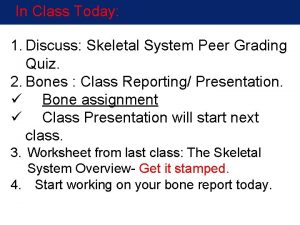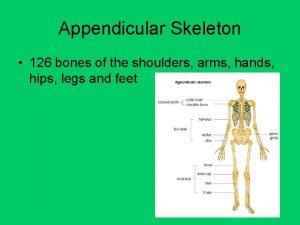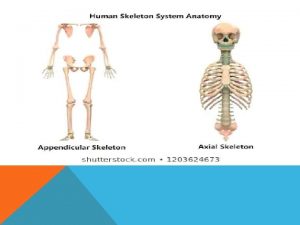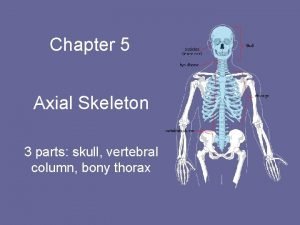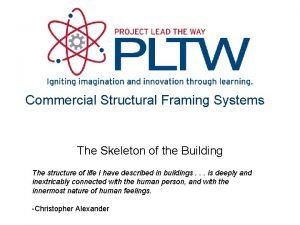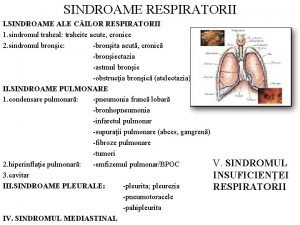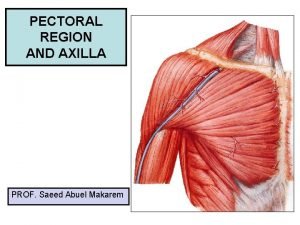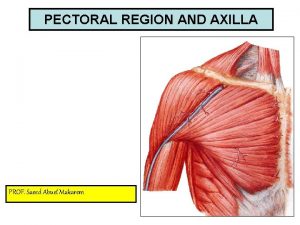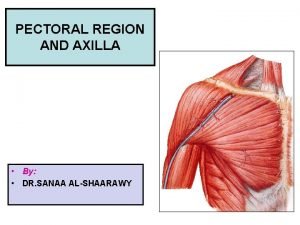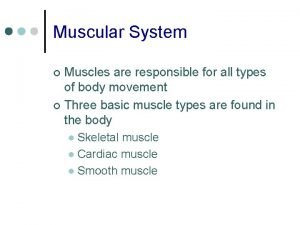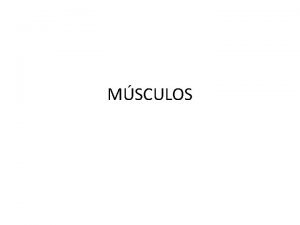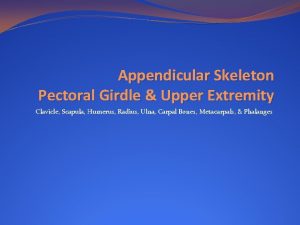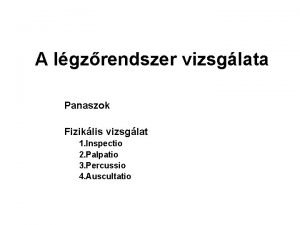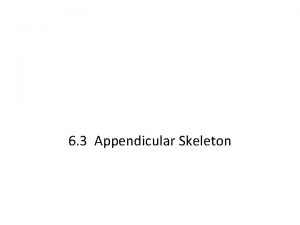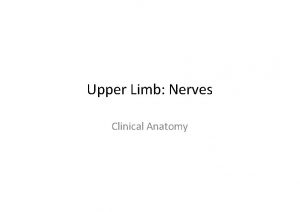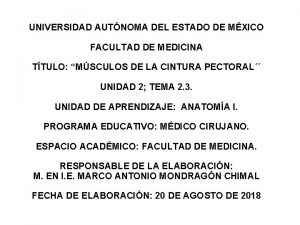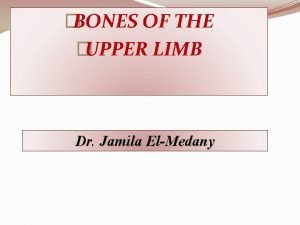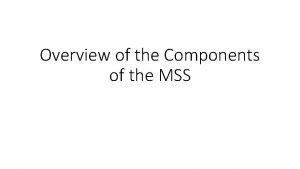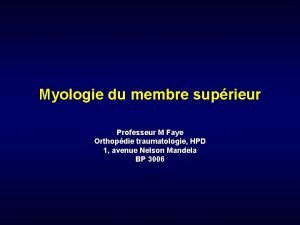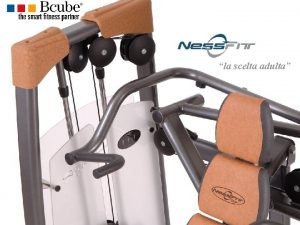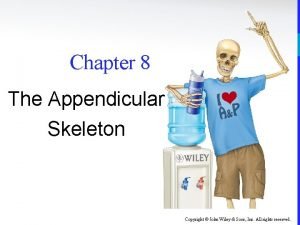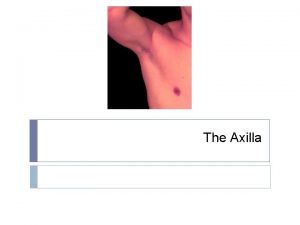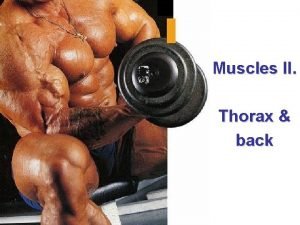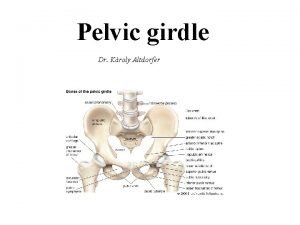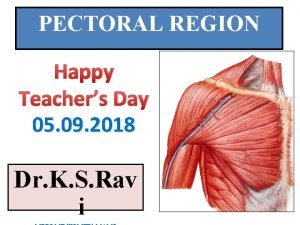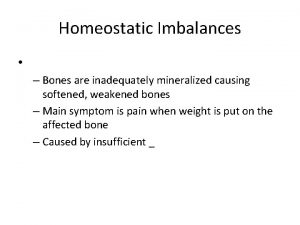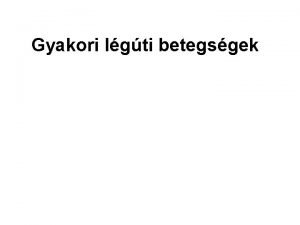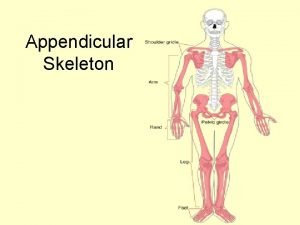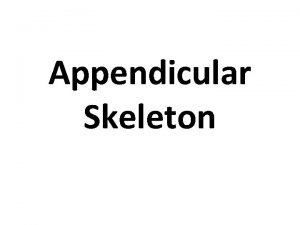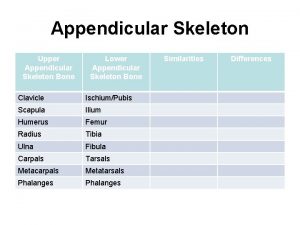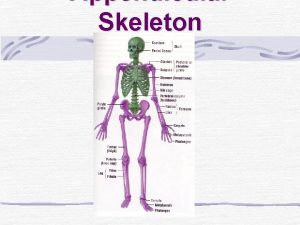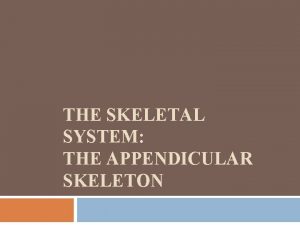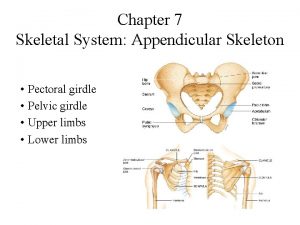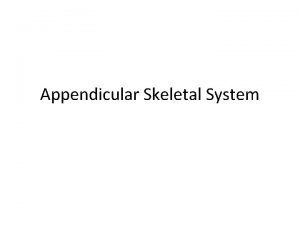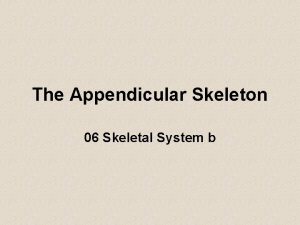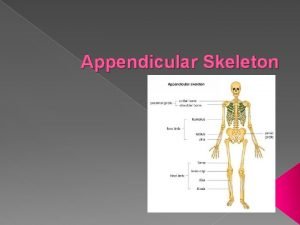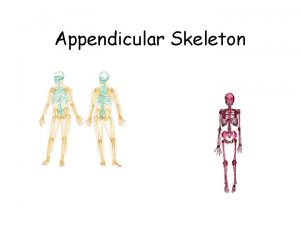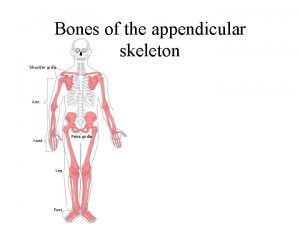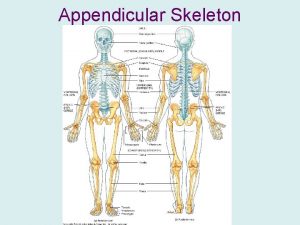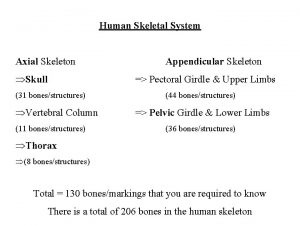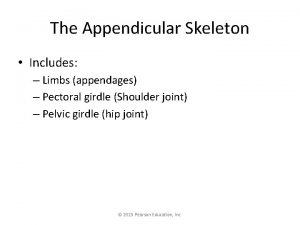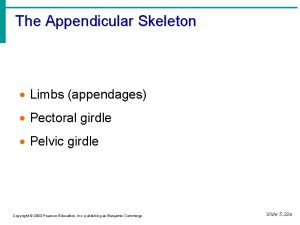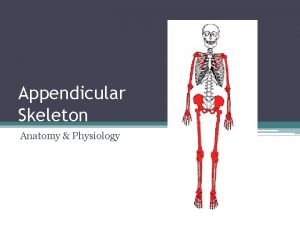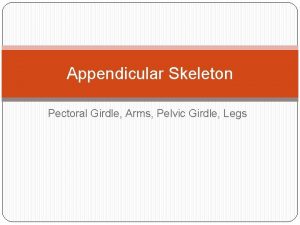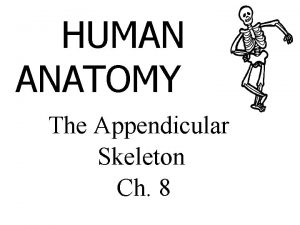THE SKELETAL SYSTEM THE APPENDICULAR SKELETON The Pectoral




















































- Slides: 52

THE SKELETAL SYSTEM: THE APPENDICULAR SKELETON

The Pectoral Girdle (Shoulder) 2 pectoral girdles attach bones of upper limbs to axial skeleton each: 1 clavicle 1 scapula

Clavicle S-shaped, (medial ½ convex anteriorly, lateral ½ concave anteriorly) slender bone lies horizontally across anterior thorax superior to 1 st rib

Clavicle medial end = sternal end is rounded & articulates with the manubrium @ sternoclavicular joint

Clavicle lateral end = acromial end is flat articulates with acromion of the scapula to form acromialclavicular joint

Clavicle last bone to stop growing 1 of most frequently fx’d bones (2 curves) usually from fall on outstretched arm or see compression fx in auto accidents from shoulder strap which can cause damage to median n. (between clavicle & 2 nd rib)

Scapula aka shoulder blade, angel bone large, triangular, flat bone in superior part of posterior thorax between levels of 2 nd & 7 th ribs spine: prominent ridge that runs diagonally across posterior surface

lateral edge: acromion a flattened expanded process, easily felt as hi pt of shoulder (tailors use it as landmark to measure length of arm) glenoid cavity: inferior to acromion, smooth, shallow depression that accepts head of humerus in shoulder joint

Scapula

Upper Limb 1. 2. 3. 4. 5. 6. 6 parts: Humerus Ulna Radius Carpals Metacarpals Phalanges Joints: Shoulder Elbow Wrist Hand

Humerus longest & largest bone of upper limb articulates proximally with scapula & distally with ulna & radius head: rounded proximal end articulates with glenoid cavity of scapula to form glenohumeral joint

Humerus

Humerus distal end: capitulum: rounded knob on lateral aspect that articulates with head of radius trochlea: medial to capitulum, spool-shaped, articulates with ulna

Humerus

Ulna medial aspect of forearm longer than radius proximal end: olecranon (prominence in elbow) distal end: head, styloid process (posterior)

Radius lateral aspect of forearm proximal end: head of radius: articulates with capitulum distal end: styloid process (palpable proximal to thumb)

Ulna & Radius 1. 2. 3. connect @ 3 places interosseous membrane proximal end distal end

Carpals proximal to the hand, distal to radius & ulna 8 small bones joined by ligaments articulations w/each other called intercarpal joints

Carpal Tunnel

Metacarpals

Phalanges 14 bones of the digits (each hand) #’d I to V beginning with thumb is the pollex has only 2 phalanges, other digits have 3 joints between phalanges called interphalangeal joints

Phalanges


Pelvic Girdle 2 hip bones (os coxa) which unite anteriorly at pubic symphysis and posteriorly with the sacrum @ sacroiliac joint

Pelvic Girdle Functions: provides sturdy support for vertebral column connects lower limb to axial skeleton

Newborn Pelvis 1. 3 bones on each side: Ilium � 2. Pubis � 3. superior anterior & inferior Ischium posterior & inferior

Ilium 1. largest of the 3 hip bones distinguishing features: Iliac Crest along superior surface Sacroiliac Joint (SI Joint) between sacrum and ilium

Ilium

Ischium 1. ramus of ischium fuses with pubis distinguishing features: Ischial Tuberosity what you feel when someone sits on your lap

Ischium

Pubis Acetabulum � formed by ilium, ischium, & pubis � is the “socket” half of the hip joint Pubic Symphysis � joint between the 2 hip bones

True Pelvis/ False Pelvis Pelvic Brim: line that distinguishes between true & false palvis

Male Pelvis generally male bone heavier & stronger & have larger surface marker (because larger muscles attach) Pelvis: � deeper false pelvis, smaller, narrower � pelvic brim heart-shaped � acetabulum larger, faces posterior � obturator foramen round

Female Pelvis generally bones lighter & thinner Pelvis: � false pelvis shallow, widers � pelvic brim larger, more oval � acetabulum smaller & faces anterior � obturator foramen oval

Male or Female?

Male or Female?

Lower Limb 30 bones in each: 1 femur 1 patella 1 tibia 1 fibula 7 tarsals 5 metatarsals 14 phalanges

Femur longest, heaviest, & strongest bone in the body proximally articulates with the acetabulum to form hip joint � Head of the Femur: “ball” part of joint small, � Greater central depression: fovea capitis Trochanter prominence felt & seen @ side of hip

Femur

Femur distally articulates with: � Patella � Tibia

Patella (kneecap) small, triangular, sesamoid bone develops in tendon of quadriceps femoris muscle Parts: Base: broad, superior end Apex: pointed, inferior end

Patella

Tibia “shin bone” larger, medial, weight-bearing bone of lower leg proximally articulates with femur & fibula distally articulates with fibula & tarsals

Tibia medial malleolus forms prominence that is palpable & visible on medial ankle

Fibula parallel & lateral to the tibia & considerably smaller head of fibula on proximal end lateral malleolus at distal end

Tibia & Fibula

Tarsals 7 bones: 1 calcaneous: heel bone, largest of the tarsals

Metatarsals 5 bones between tarsals & phalanges #’d I to V from medial lateral

Phalanges 14 bones that make up the 5 digits #’d I to V medial to lateral Hallux: great or big toe has 2 large heavy phalanges

Arches of the Foot 2 arches in foot: 1. allows the foot to support weight of body by distributing weight over the soft & hard tissues 2. provide leverage while walking fully developed by age 12 - 13

Arches of the Foot 2 longitudinal arches (medial & lateral 1 transverse arch

 Appendicular skeleton pectoral girdle
Appendicular skeleton pectoral girdle Axial vs appendicular skeletal system
Axial vs appendicular skeletal system Appendicular vs axial skeleton
Appendicular vs axial skeleton Xiphosternal joint
Xiphosternal joint Appendicular skeletal system
Appendicular skeletal system Difference between axial and appendicular skeleton
Difference between axial and appendicular skeleton Figure 6-4 the skeleton axial and appendicular divisions
Figure 6-4 the skeleton axial and appendicular divisions Figure 6-4 the skeleton axial and appendicular divisions
Figure 6-4 the skeleton axial and appendicular divisions Figure 6-4 the skeleton axial and appendicular divisions
Figure 6-4 the skeleton axial and appendicular divisions Copyright
Copyright Figure 6-4 the skeleton axial and appendicular divisions
Figure 6-4 the skeleton axial and appendicular divisions Axial skeleton skull worksheet chapter 5
Axial skeleton skull worksheet chapter 5 Appendicular skeleton 126 bones
Appendicular skeleton 126 bones Labeling appendicular skeleton
Labeling appendicular skeleton Lower extremity appendicular skeleton
Lower extremity appendicular skeleton Chapter 7 skeletal system
Chapter 7 skeletal system 7:4 skeletal system
7:4 skeletal system Chapter 5 the skeletal system axial skeleton skull
Chapter 5 the skeletal system axial skeleton skull Skeleton steel framing system
Skeleton steel framing system Frecatura pleurala
Frecatura pleurala Superficial pectoral fascia
Superficial pectoral fascia Boundaries of axilla
Boundaries of axilla Nerve to subclavius
Nerve to subclavius Nerve supply to serratus anterior
Nerve supply to serratus anterior Pectoral girdle muscles
Pectoral girdle muscles Tricep braquial funcion
Tricep braquial funcion Articulacion acromioclavicular
Articulacion acromioclavicular Pectoral girdle diagram
Pectoral girdle diagram Pectoral fremitus
Pectoral fremitus Pectoral girdle
Pectoral girdle Lateral pectoral nerve
Lateral pectoral nerve Músculo subescapular
Músculo subescapular Pectoral de tutankamon
Pectoral de tutankamon Musculos del miembro superior
Musculos del miembro superior Spinal cord anatomy
Spinal cord anatomy Largest bone
Largest bone Lbinder
Lbinder Thorax
Thorax Dorsal postion
Dorsal postion Pectoral fascia
Pectoral fascia Abducteur
Abducteur Biomekanik shoulder joint
Biomekanik shoulder joint Leg curl
Leg curl Elbow joint diagram
Elbow joint diagram Axilla posterior wall
Axilla posterior wall Trapezius pars spinalis
Trapezius pars spinalis Upper ab workouts
Upper ab workouts Le lieu saint et le lieu tres saint
Le lieu saint et le lieu tres saint Pelvis major and minor
Pelvis major and minor Clavipectoral fascia
Clavipectoral fascia Comblement sillon delto pectoral
Comblement sillon delto pectoral Homeostatic imbalances of the skeletal system
Homeostatic imbalances of the skeletal system Pectoral fremitus
Pectoral fremitus


